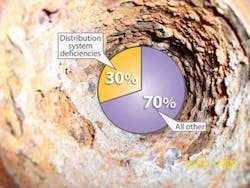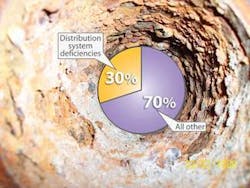Water Distribution Systems:The New Frontier In Protecting Public Health
The water distribution system is alive and breathing. Historically the major focus of Environmental Protection Agency (EPA) regulations has been on the water treatment plant - improving its performance relative to removing and inactivating microorganisms, and removing particles and harmful chemicals or precursors to various by-products. Those measures have been quite effective at improving water quality and reducing public health risks. The latest round of regulations continues with that approach to further stretch the limits of water treatment technology.
The next round of regulations will turn its focus to the distribution system - the final barrier to protecting water quality before it reaches the consumer. We now know that the piping system is a living, breathing biological and chemical reactor. The conditions are not sterile, nor are they static. Microbes are growing and continually sloughing off, and chemical reactions and corrosion proceed after the water leaves the treatment plant.
Public health experts have indicated that 30 percent of recent waterborne outbreaks were attributable to distribution system deficiencies. As the number of outbreaks attributable to treatment continues to decrease, the percent of those linked to distribution system deficiencies will likely increase.
EPA is gathering technical information as a prelude to future rulemaking that will affect the distribution system. The actions being considered include revising the Total Coliform Rule and/or developing a Distribution System Rule. As part of the information-gathering efforts, EPA has developed a series of white papers describing the status of what is known on the following subjects:
About the Author:
Gregory Kirmeyer, P.E., is HDR’s national director of drinking water. He has more than 28 years of industry experience primarily related to drinking water quality. He may be contacted via e-mail at [email protected].


